These real sea creatures sparked legends of krakens, mermaids, and monsters
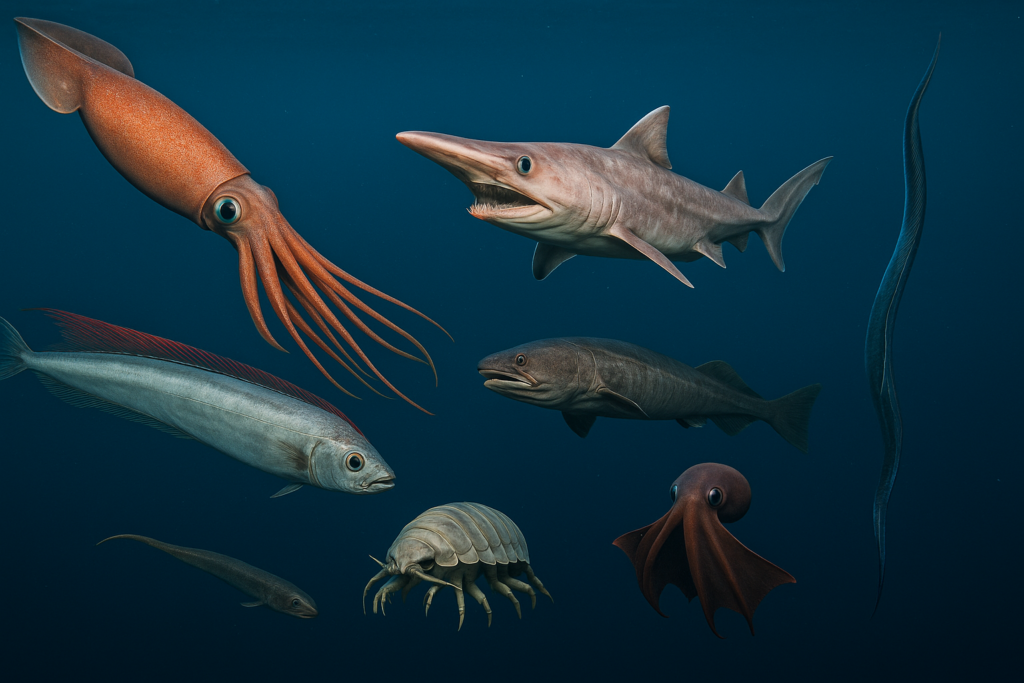
Giant Squid
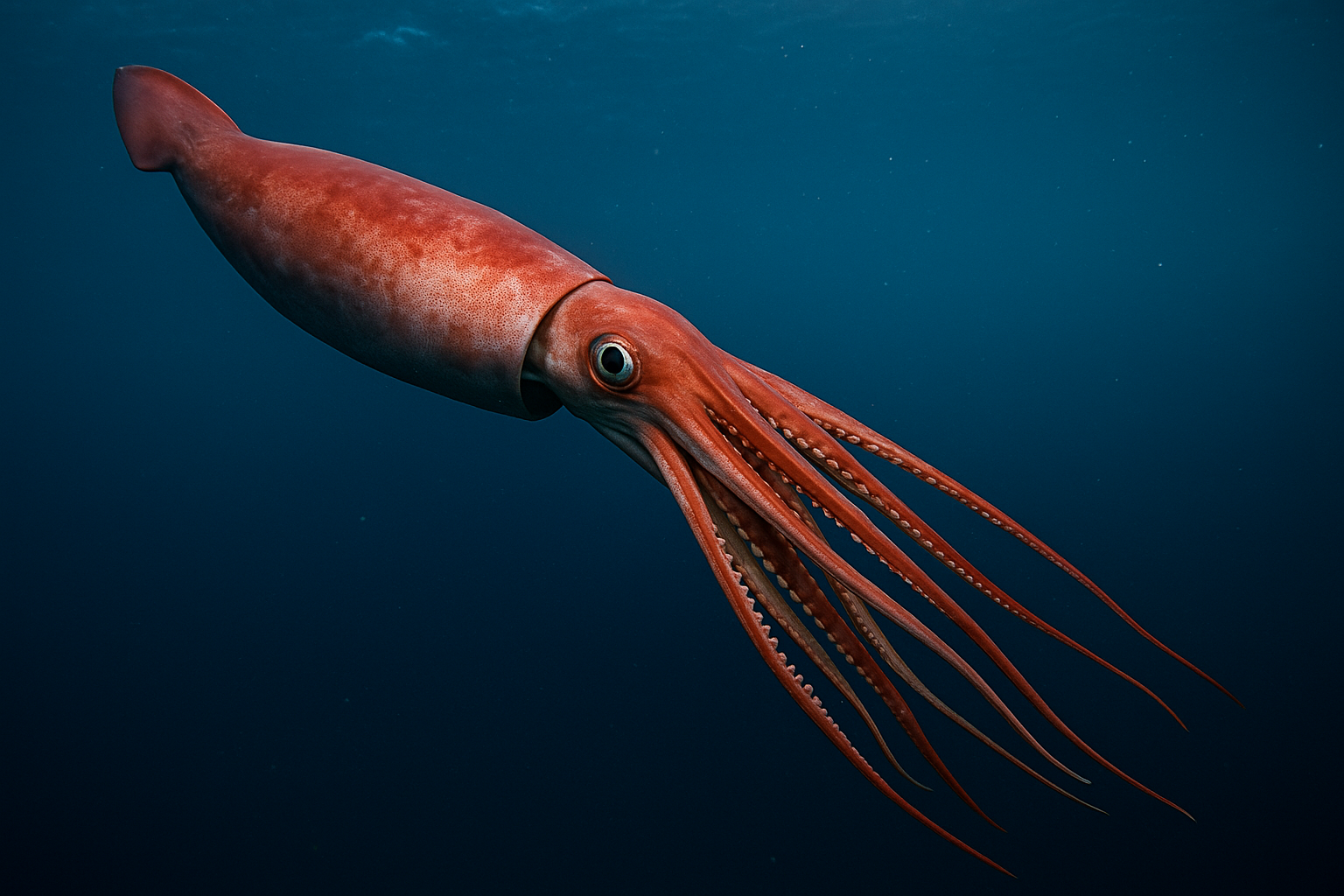
In the icy waters of Norse legend, few creatures were feared more than the Kraken, a beast so massive it could drag entire ships into the depths and summon whirlpools with a flick of its limbs. Sailors whispered about it in hushed tones, describing a nightmare with arms like tentacles, eyes like moons, and a hunger for timber and flesh. The Kraken first appeared in Scandinavian texts as early as the 13th century, gaining infamy in later seafaring folklore from Iceland to Norway. Some said it could be mistaken for an island, while others claimed its stench was so foul it could be smelled miles away. The myth wasn’t just fear, it was survival instinct, warning generations of mariners about the mysteries lurking beneath uncharted seas.
That myth got a reality check in the 19th century, when beached remains and sucker-scarred whales confirmed the giant squid (Architeuthis dux) was very real. These elusive cephalopods can reach lengths of up to 43 feet, with eyes the size of basketballs and tentacles lined with serrated suckers that can leave deep gouges in whale flesh. They dwell thousands of feet beneath the surface, rarely seen alive until the early 2000s, when Japanese researchers captured the first live footage. Their alien-like bodies and fluid movements make them seem more fantasy than fact, yet they are one of the ocean’s most awe-inducing apex enigmas. Source: Smithsonian
2. Oarfish
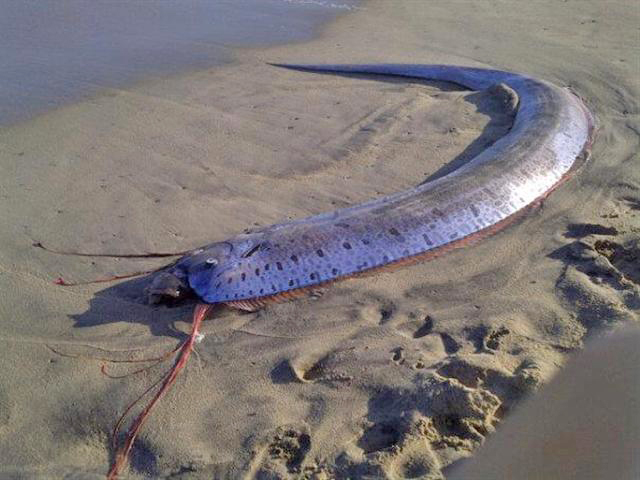
In nearly every seafaring culture, stories of giant sea serpents slithering just beneath the waves stirred fear and awe in equal measure. Ancient Greeks warned of sea dragons, while Japanese fishermen believed in long, silver-bodied ryū that foretold disaster. Even European sailors of the 18th and 19th centuries reported seeing “serpents” over 30 feet long, gliding through the water with a ghostly shimmer. These sightings were often considered omens, harbingers of earthquakes, typhoons, or deaths at sea. Their appearances were so dramatic that naturalists began documenting accounts, sketching creatures that looked too long, too smooth, and too silent to belong to this world. The myth of the sea serpent, while shifting in shape, became one of the ocean’s most persistent legends.
The real creature behind many of these reports is likely the oarfish, an incredibly long, ribbonlike fish that can grow up to 36 feet and rarely appears near the surface unless ill or dying. With its iridescent, scaleless body and crimson crown-like fins, the oarfish doesn’t just look mythic, it practically floats like a flag through the water column, moving vertically or horizontally like a gliding ribbon. Living in the twilight zone between 600 and 3,000 feet deep, it’s usually hidden from view, adding to its legendary mystique. But when one does wash ashore or rise near a fishing vessel, its alien beauty and sheer size make it easy to see why entire myths sprung up around it. Source: National Geographic
3. Frilled Shark
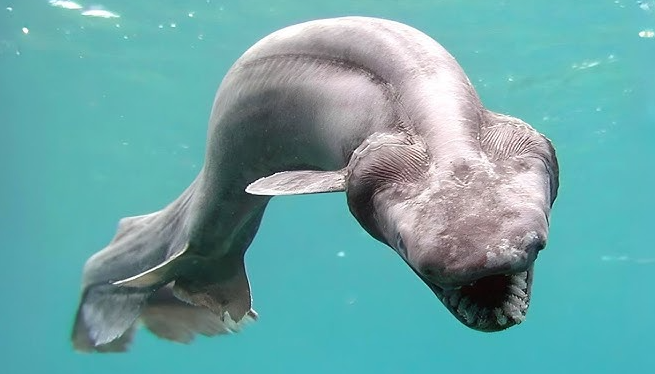
Long before science reached the ocean’s blackest trenches, tales of sea demons and serpent-like beasts spread through port towns and fishing villages. Medieval European bestiaries described monsters with eel-like bodies, mouths full of needles, and movements that twisted unnaturally through the water like cursed spirits. These were not noble sea serpents but horrors, creatures said to pull down divers or shipwreck lone swimmers. In Japanese folklore, similar beings appeared as umibōzu, shapeless sea monsters capable of cursing those who dared challenge the ocean. Across cultures, the myth was the same: something ancient and ugly lived deep below, and its eyes had seen more than any man ever would.
That terror might be traced to the frilled shark, a rarely seen deep-sea predator that looks frozen in time. With over 300 trident-shaped teeth arranged in rows and a gaping, flexible jaw, the frilled shark (Chlamydoselachus anguineus) is an authentic relic from the age of dinosaurs. It swims with the slithering grace of a sea serpent and can reach up to 6.5 feet long, though its sinuous frame makes it appear longer in motion. Its gills form frilly ridges along its neck, giving it a frilled, almost Elizabethan collar appearance, equal parts regal and horrifying. Deep-sea submersibles have occasionally caught one alive on camera, but even modern scientists admit it looks more like something from a nightmare than a National Geographic special. Source: NOAA
4. Goblin Shark
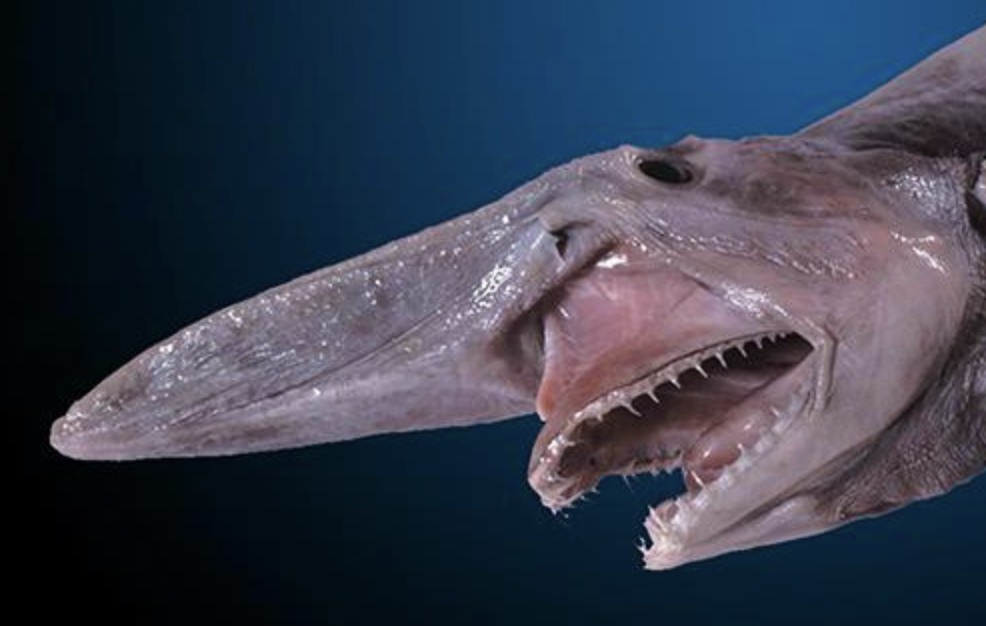
Japanese legends are packed with deep-sea goblins and shapeshifting sea spirits, beings with distorted faces, long noses, and the ability to appear from the depths with terrifying speed. One such figure, the tengu, was said to guard forbidden places, often with a hideous snout and grotesque features. Though more often associated with mountains, tengu were also believed to appear near coastal waters, linked to drowned souls and supernatural forces. Other tales featured creatures with long, spike-like appendages or demonic jaws, surfacing from the darkness to snatch fishermen off their boats. These monsters were rarely seen, always feared, and described with such detail that they seemed too bizarre to be imagined.
Enter the goblin shark (Mitsukurina owstoni), a deep-sea predator that looks more mythical than an animal. With a long, flattened snout and a jaw that can catapult forward to snatch prey, the goblin shark has translucent pinkish skin and a ghoulish appearance that has earned it the nickname “living fossil.” It can reach up to 13 feet in length and lurks more than 4,000 feet below the surface. What truly sets it apart is its extendable jaw, which can launch outward with terrifying speed to snag fish and squid, a feature almost tailor-made for legends. First discovered in the late 1800s, the goblin shark is rarely seen, yet every blurry photo or accidental catch seems to confirm what Japanese fishermen already knew, some monsters are real. Source: Smithsonian Ocean
5. Colossal Squid
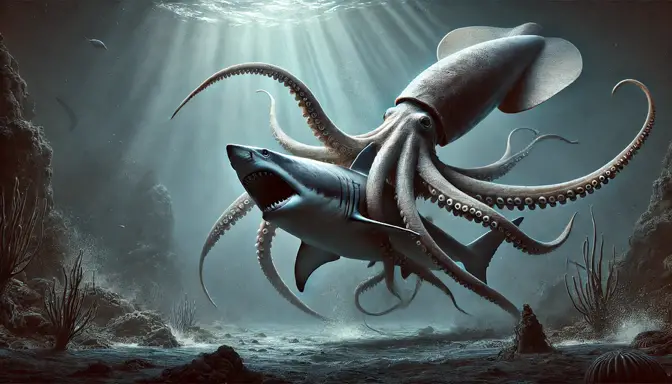
While the Kraken haunted Norse myths, the southern seas had their own version of the tentacled nightmare. Early whalers and Antarctic explorers spoke of beasts that lived in the icy depths, creatures with eyes like lanterns and arms thick enough to wrap around small boats. These weren’t just exaggerations from storm-battered sailors. In some cases, entire whale carcasses were discovered with massive sucker marks and deep gouges, leading to whispered tales of sea beasts too large and ferocious to be imagined. These Antarctic terrors were said to strike from the deep, unseen until it was far too late. Some even believed these monsters dragged whales into the cold blackness, never to surface again.
They weren’t far off. The colossal squid (Mesonychoteuthis hamiltoni) is one of the most elusive and extreme predators in the ocean. Larger and heavier than the giant squid, it can weigh over 1,000 pounds and stretch up to 46 feet long. Its most terrifying feature isn’t just its size, it’s the swiveling hooks embedded in its tentacles, used to grip and shred prey. With eyes the size of dinner plates, the largest in the animal kingdom, the colossal squid is uniquely adapted for the pitch-black pressures of the Southern Ocean. Almost nothing is known about how it lives, because live sightings are almost nonexistent. But the evidence left behind on sperm whales and in trawl nets proves that something enormous and armed still rules the Antarctic deep. Source: Te Papa Museum of New Zealand
6. Sperm Whale
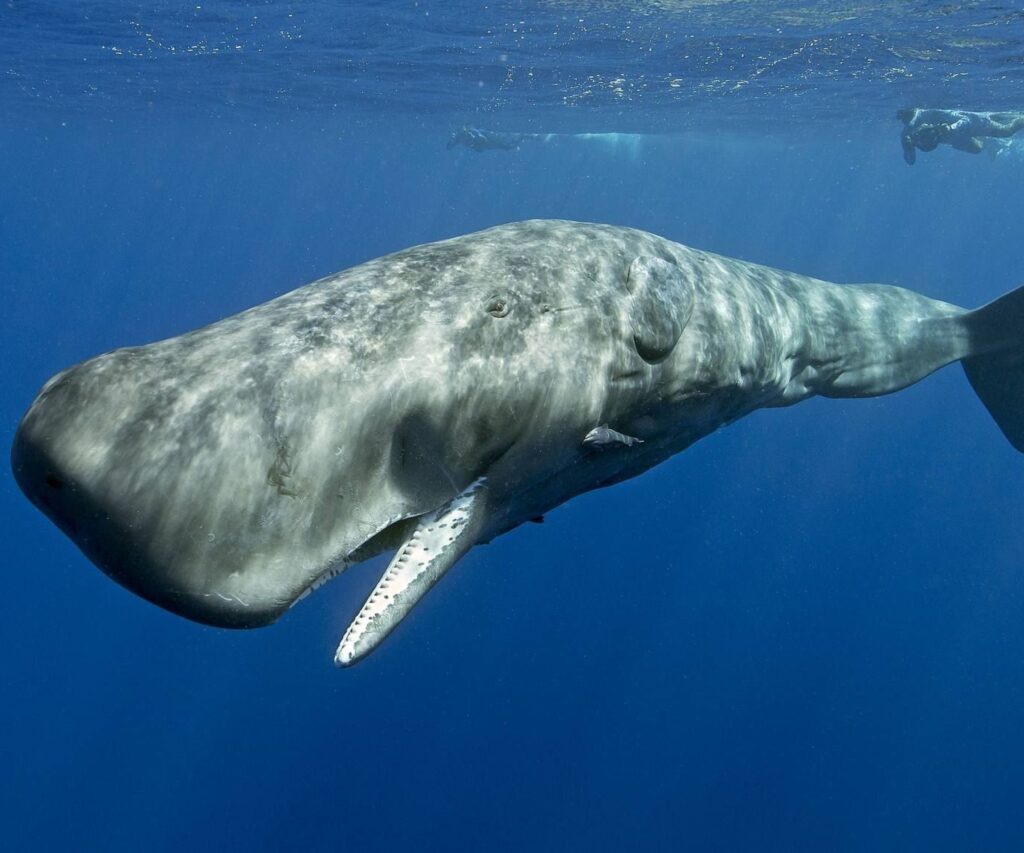
The Leviathan looms large in biblical and ancient texts, a sea monster of unimaginable size, said to snort smoke from its nostrils and crush ships with a single roll of its body. In the Book of Job, it’s described as a fire-breathing beast that “makes the depths churn like a boiling cauldron.” Later interpretations across cultures painted the Leviathan as a massive serpent or whale-like creature with monstrous jaws, scales like shields, and a presence so terrifying that even gods hesitated to challenge it. From ancient Hebrew texts to later Christian and Islamic traditions, it symbolized chaos, divine wrath, and the unfathomable power of the deep.
While some scholars view the Leviathan as symbolic, others trace it directly to real sea creatures chief among them, the sperm whale (Physeter macrocephalus). These deep-diving giants can grow over 60 feet long and weigh up to 45 tons. With massive square heads, a clicking sonar so loud it can stun prey, and a talent for battling colossal squid thousands of feet below the surface, sperm whales are worthy of myth. Their dramatic surfacing, powerful tail slaps, and haunting vocalizations add to their otherworldly aura. For centuries, they were feared by sailors not just for their size but for the explosive violence they could unleash when harpooned as seen in the true story that inspired Moby-Dick. Source: American Museum of Natural History
7. Portuguese Man o’ War
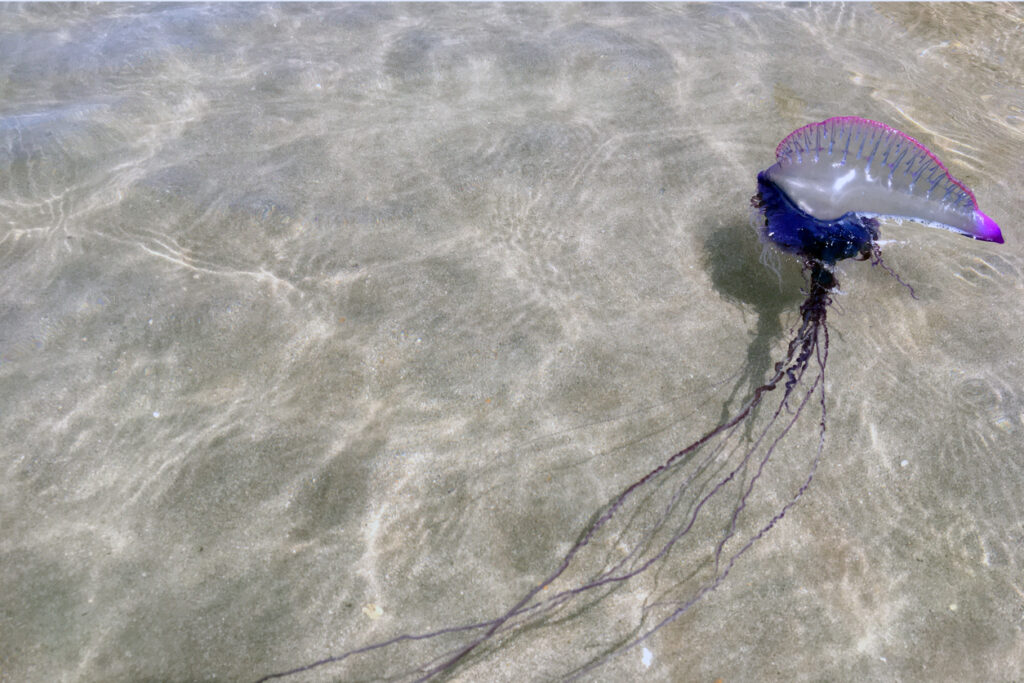
Sailors once feared sirens not just for their songs, but for the strange, floating creatures that drifted silently across the sea, beautiful, translucent beings that seemed to glow under sunlight. Some believed these ghostly entities were traps set by sirens, luring sailors overboard or marking places of no return. In Caribbean and Mediterranean folklore, jellyfish-like apparitions were said to sting with the force of a curse, leaving behind blistered skin and madness. These floating specters were described as part-animal, part-spirit—deadly despite their delicate appearance, and often mistaken for something supernatural drifting just below the waves.
That eerie apparition turns out to be very real: the Portuguese Man o’ War (Physalia physalis), a colonial organism made up of specialized zooids that function together as one. With its bubble-like sail and trailing blue-purple tentacles that can reach over 100 feet, it looks more like a sea witch’s spell than a living animal. Though it resembles a jellyfish, it’s technically a siphonophore, drifting on ocean currents while its tentacles deliver venom powerful enough to paralyze small fish and inflict excruciating pain in humans. Found mostly in tropical and subtropical waters, it stings thousands of swimmers each year and is often mistaken for plastic or seafoam. One touch, however, makes its presence unforgettable. Source: National Ocean Service
8. Steller’s Sea Ape
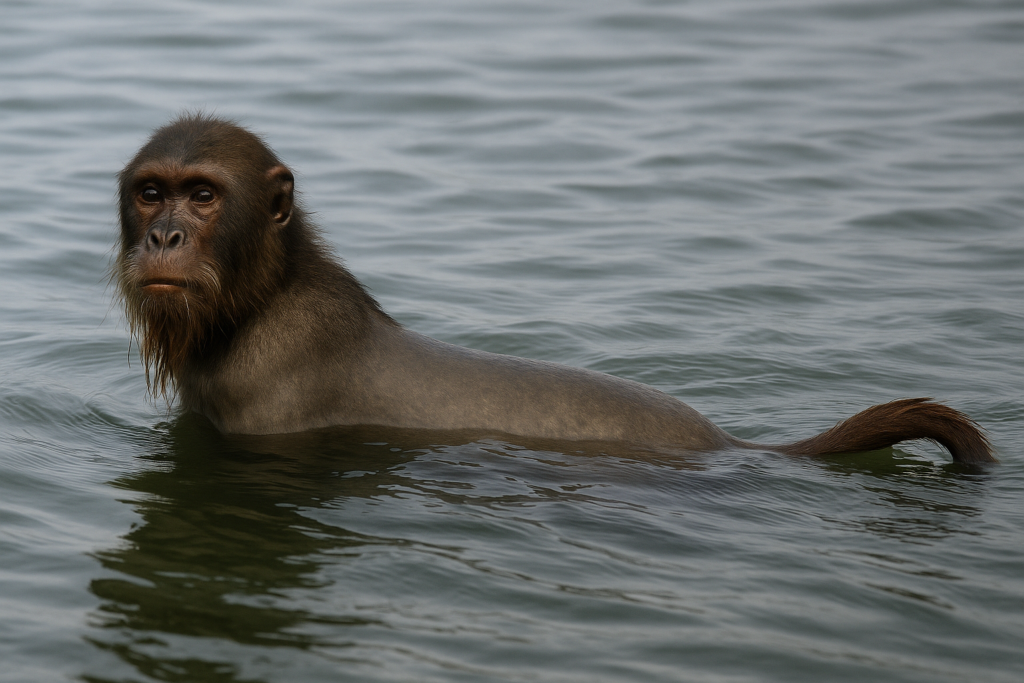
In 1741, during a Russian expedition off the coast of Alaska, German naturalist Georg Wilhelm Steller claimed to see something utterly bizarre: a creature with the body of a dog, the whiskered face of a monkey, and the behavior of a playful human. He described it tumbling through the waves, leaping like a porpoise, and even appearing to mock the crew as it swam beside the ship. It had thick reddish fur, long forelimbs, and no visible flippers, nothing like any known animal. Steller, a meticulous observer, dubbed it the “sea ape,” and though no one else on his voyage reported a sighting, his detailed account added a strange new player to maritime mythology. For centuries after, sea apes appeared in sketches and sailor lore, described as half-mermaid, half-mischief.
Modern scientists believe Steller may have misidentified a real animal, possibly a juvenile northern fur seal (Callorhinus ursinus) or a large sea otter behaving unusually. Both species inhabit the region, and young fur seals can be agile, curious, and oddly proportioned, especially when viewed from a ship’s deck in poor conditions. Still, no confirmed second sighting of a true “sea ape” has ever occurred, making Steller’s creature one of the more tantalizing examples of a real animal inspiring a myth, especially one that blurs the line between primate and pinniped. Source: Skeptical Inquirer
9. Basking Shark
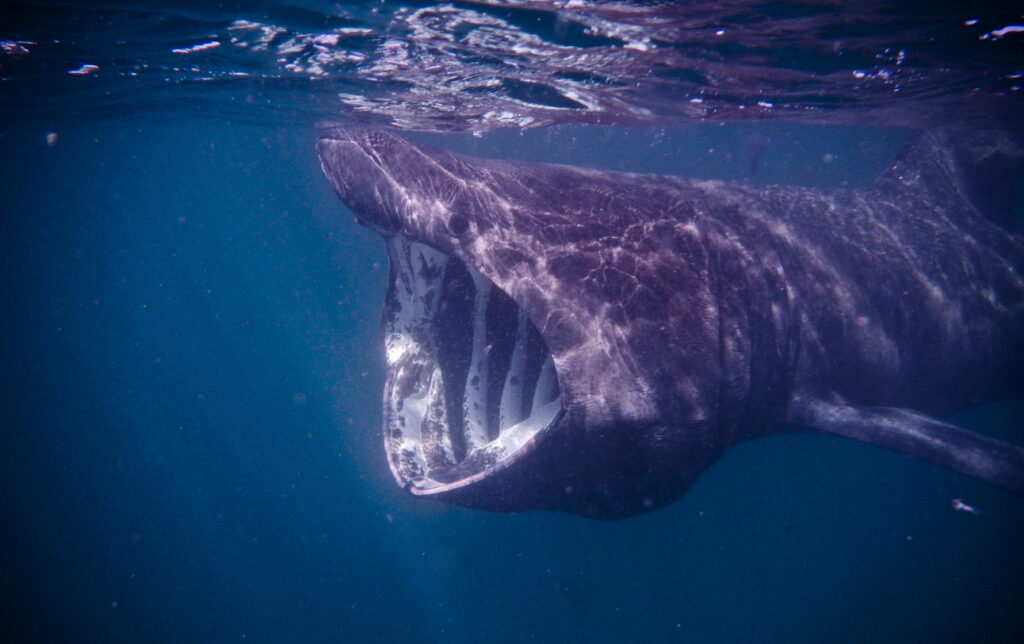
Throughout the 1800s and early 1900s, mysterious sea carcasses occasionally washed ashore with long necks, tiny heads, and bloated torsos, instantly labeled as “sea monsters” or modern-day plesiosaurs. One of the most famous was the so-called “Stronsay Beast,” found in Scotland in 1808, which sparked a frenzy of cryptozoological speculation. The creature appeared serpent-like and otherworldly, lacking the signature dorsal fin of a known shark and instead sporting cartilage and stringy remains that gave it a prehistoric vibe. For decades, these decomposed marine mysteries fed legends of surviving dinosaurs and vindicated the idea that the ocean still held ancient horrors from a forgotten age.
But scientists eventually solved the mystery: most of these cases were actually basking sharks (Cetorhinus maximus) in an advanced state of decay. When a basking shark decomposes, its lower jaw and gill arches break down first, creating the illusion of a long neck and tiny skull. The second-largest fish in the ocean, basking sharks can grow up to 40 feet long and cruise near the surface with mouths wide open, filtering plankton with gill rakers. Despite their size, they’re harmless to humans, but their eerie silhouettes and misleading remains have made them some of the most misidentified creatures in sea monster history. Source: Natural History Museum
10. Anglerfish
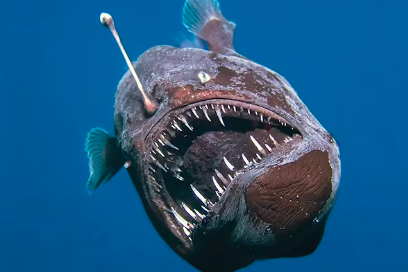
Long before anyone understood bioluminescence, sailors spoke of lights dancing beneath the waves, glimmers that would appear in the blackest waters, just out of reach. Some said they were lanterns held by drowned spirits. Others believed they were the bait of sirens, used to lure men to their deaths. In certain Mediterranean and Nordic legends, glowing orbs seen at sea were said to mark cursed ships or bewitched currents. The idea of a creature that used its own light to deceive and devour became a recurring theme in nautical folklore, particularly when describing vanishing fishermen or mysterious disappearances during calm seas.
The truth behind many of those tales may live in the abyss: the anglerfish. These deep-sea predators, particularly the species Melanocetus johnsonii, are equipped with a bioluminescent lure protruding from their foreheads, a glowing bait that pulses in the pitch-black deep to attract prey. With massive jaws and needle-like teeth, the anglerfish can consume animals nearly its own size. Females, which grow up to a foot long, dwarf the tiny males, who fuse to them parasitically. These grotesque, floating traps dwell at depths of 2,000 to 6,000 feet, where light doesn’t reach, yet they carry their own eerie glow like a haunted lure from myth. Source: MBARI
11. Giant Isopod
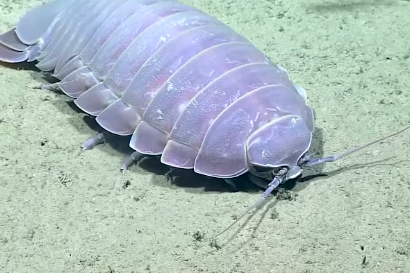
Ancient legends often warned of sea bugs, armored, creeping things that scuttled along the ocean floor and feasted on the remains of the dead. In Japanese and Filipino folklore, creatures known as bakunawa and kataw were sometimes described as crustacean-like monsters that rose from shipwrecks or graveyards at sea, devouring bodies whole or clinging to the hulls of vessels like cursed barnacles. Sailors told stories of grotesque, many-legged horrors discovered in deep nets, their cold, unblinking eyes and armored plates resembling the spawn of some ancient underworld. Unlike sea serpents or krakens, these monsters didn’t rise in dramatic battles, they lurked, crawled, and consumed.
Meet the giant isopod (Bathynomus giganteus), a real-life relic that looks like a roach engineered for a post-apocalyptic ocean. Growing up to 20 inches long, it’s one of the largest known isopods and thrives at depths between 500 and 7,000 feet. Its exoskeleton is pale and plated, its antennae twitch constantly, and its numerous legs let it scurry across the seafloor like a nightmarish tank. A scavenger by nature, it feeds on whale falls, fish carcasses, and anything unfortunate enough to settle in the muck. With its eerie stillness and prehistoric form, the giant isopod doesn’t need myth to make it feel otherworldly, it already looks like it clawed its way out of a sailor’s worst nightmare. Source: Ocean Conservancy
12. Sawfish
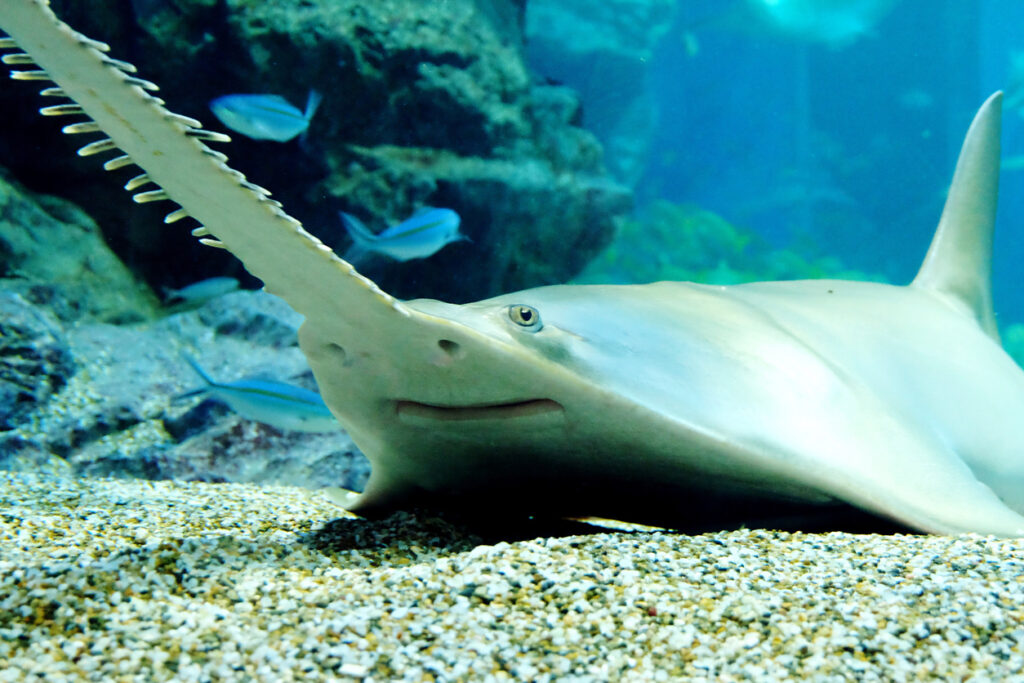
In stories from ancient India to West Africa, there were whispers of guardian creatures armed with swords, beasts said to slice through nets, boats, or even men. Some legends described them as aquatic gods or spirits that wielded weapons to punish greed and overfishing. Others called them sea demons, using long, serrated blades to lash out at those who disturbed sacred waters. Early explorers brought home tales of “fish with saws,” dismissing them as exaggerations or fables. Yet carved relics and ancient depictions of sword-snouted sea monsters show these creatures were feared, respected, and possibly worshipped.
The reality is just as strange: the sawfish, a ray relative with a long, flat snout edged like a chainsaw, called a rostrum. That saw, lined with sharp tooth-like structures, can be nearly half the length of the fish’s body, which itself can stretch up to 25 feet in the largest species. Far from ornamental, it’s a hunting tool, used to slash through schools of fish or detect prey through electroreception buried in sand. Found in both saltwater and freshwater environments, sawfish are critically endangered due to habitat loss and demand for their striking snouts. But in murky, shallow water, when one glides past like a weapon brought to life, it’s easy to see why ancient mariners turned their stories into legend. Source: NOAA Fisheries
13. Sea Spider
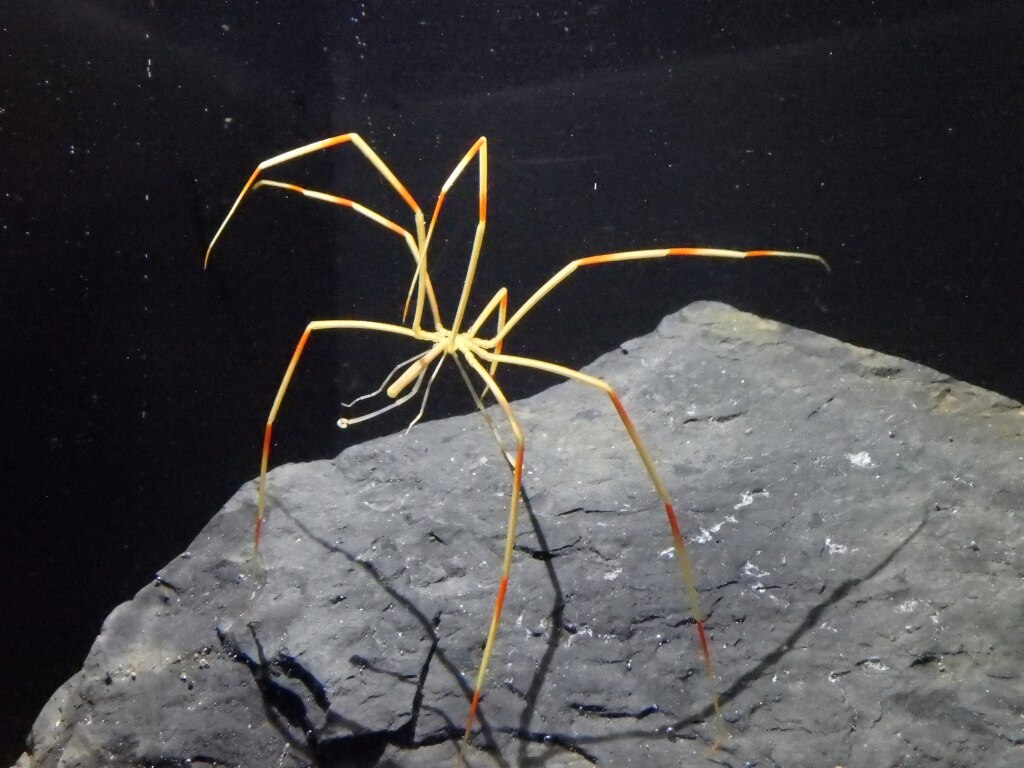
In ancient myths, creatures with too many legs often symbolized chaos, disease, or demons from the deep. Fishermen told of spider-like horrors that scuttled across the ocean floor, weaving invisible traps or poisoning the water itself. In Norse and Inuit tales, some spoke of “bone walkers” or “grip ghosts” spindly-limbed monsters that could paralyze their prey and disappear between cracks in ice or coral. These weren’t massive beasts, but their unnatural movements and eerie silence made them all the more unnerving. To see one was to glimpse something not meant for human eyes, a living relic from the earliest nightmares of the sea.
Those nightmares are shockingly real. Sea spiders, or pycnogonids, aren’t true spiders but arachnid-like marine arthropods with long, thin legs that make up most of their body mass. Some species measure just a few millimeters, but deep-sea varieties can reach over 20 inches across. Found in the coldest, darkest parts of the ocean, including Antarctica, they absorb oxygen directly through their legs and often lack true organs altogether. Their gangly, alien appearance and slow, deliberate movements make them seem more like something from a deep-space horror film than Earth’s oceans. Though they pose no threat to humans, encountering one in the deep would feel like staring into a myth that crawled into reality. Source: MBARI
14. Vampire Squid
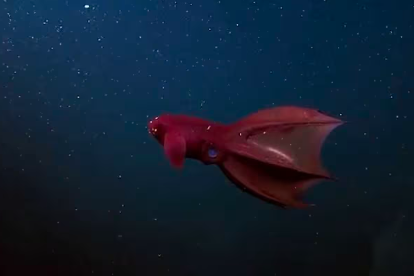
Legends of underwater spirits and deep-sea vampires have haunted maritime folklore for centuries. These beings weren’t just bloodthirsty—they were cloaked in darkness, gliding silently through the water with arms outstretched like shrouds. In some versions, they were guardians of the abyss, collecting the souls of drowned sailors. In others, they were demons that enveloped their victims in shadow before dragging them to the seafloor. The idea of a creature with a cape, floating effortlessly in the black void, appears in everything from Greco-Roman sea tales to Polynesian underworld myths. They weren’t just monsters, they were messengers from the deepest places we were never meant to go.
That myth may have been inspired by the vampire squid (Vampyroteuthis infernalis), a bizarre deep-sea cephalopod whose name literally means “vampire squid from hell.” Despite its terrifying name, it doesn’t suck blood but it does look like a swimming shadow. Its cloak-like webbing connects eight arms lined with soft spines, and when threatened, it flips the web over itself in a chilling “inside-out” display. Measuring around a foot long, it lives in oxygen-deprived depths up to 3,000 feet, where few predators dare roam. It glows with bioluminescent tips and ejects a cloud of mucus filled with glowing particles instead of ink, a true spectacle of spectral defense. Source: Monterey Bay Aquarium
15. Ribbon Eel
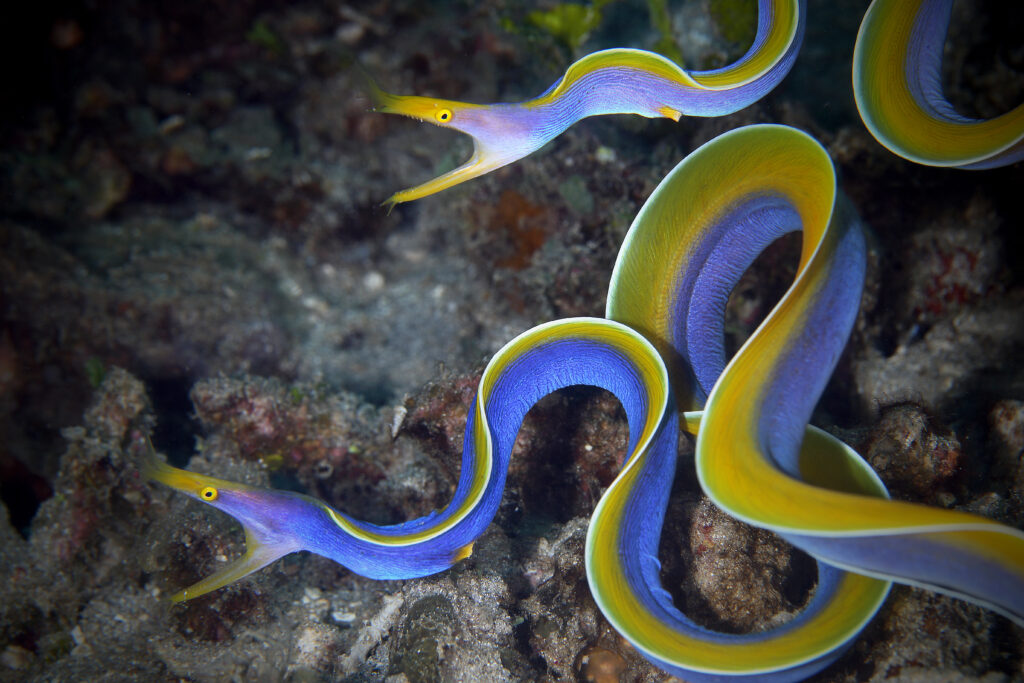
Stories of water dragons span the globe, from the sinuous nāga of Southeast Asia to the feathered serpents of Mesoamerica. These mythical creatures were said to live in rivers, reefs, or sea caves, emerging only during storms or sacred moments. Brightly colored, constantly in motion, and nearly impossible to catch, they were seen as omens, messengers, or gods. Sailors in the Indo-Pacific sometimes reported seeing long, ribbon-like creatures slithering through coral with brilliant blue or yellow hues, mistaking them for baby sea dragons or underwater serpents. Their flicking jaws and hypnotic movements only added to their legend, especially when glimpsed for mere seconds in the shadows of a reef.
The real creature behind some of those sightings is the ribbon eel (Rhinomuraena quaesita), a jaw-dropping member of the moray eel family. Found in the Indo-Pacific, it can grow up to 4 feet long and has a slender, fluttering body that looks like silk flowing in water. Males are electric blue with yellow accents, while females turn yellow as they mature, a color-shifting ability that likely added to their mystique. With flared nostrils, a gaping mouth, and undulating motion, the ribbon eel seems less like a fish and more like an enchanted scroll come to life. It hides in burrows and coral crevices, lunging at prey with lightning speed, all while looking like a creature from myth made real. Source: Australian Museum
Even in the age of sonar scans and deep-sea submersibles, the ocean still has a way of blurring the line between myth and biology. These creatures prove that ancient legends weren’t always fantasy; sometimes, they were just early observations of life so strange it defied belief. From tentacled leviathans to glowing lures in the abyss, the real monsters of the sea are often more fascinating than fiction.
If this gave you chills (or made you want to cancel your next beach trip), stick with us. Fetch dives deep into the strangest corners of the natural world, where folklore, science, and curiosity collide.


